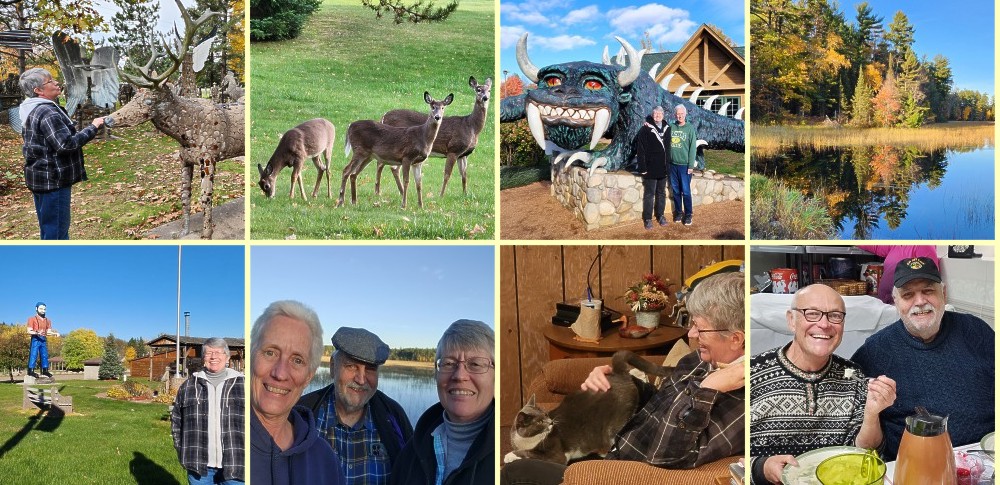Kansas Snapshots by Gloria Freeland - November 3, 2023
Laona, Larry, lutefisk, lakes and more
Husband Art and I have been traveling to our Wisconsin "cabin in the woods" some 30-plus years, and I'm always amazed by the
crystal-clear lakes, pine forests, and serenity of the state's northwoods. I appreciated it even more on our visit last month.
It was a great place to rest and recuperate during our recent bout with Covid. But another special aspect was my sister Gaila
was able to join us - the first time she's ever set foot in the Badger State.
Gaila is as easily amused by small things as Art and I are. So while we wanted to show her as many things as possible in her
short stay with us, we also wanted to spend as much time just chilling as we could.
She and I took several walks along Maple Lake, which is only 50 yards or so from the front door of our cottage. We drove through
the nearby Nicolet-Chequamegon National Forest - past nearly-hidden lakes, across small streams, and along roads edged with miles
and miles of green and yellow canopy. White-tailed deer, wild turkeys, geese, chipmunks, and gray and black squirrels were among
the critters we saw on our walks and drives.
I had been afraid the fall colors would be gone, but my fears were unfounded. Set against the dark-green evergreens and deep blue
skies created by cool nights, the yellows of the white birch and tamarack trees were spectacular, and the reds and oranges of the
maples were brilliant. In fact, the palette was as near the peak of autumn colors as I’ve ever seen.
We traveled to Phillips to visit the Wisconsin Concrete Park, an outdoor museum with 237 concrete-and-mixed-media sculptures built
between 1948 and 1964 by Fred Smith, a retired lumberjack and self-taught artist and musician. Installed throughout Smith's
northwoods property, the site is a panorama of life-size and larger-than-life-size sculptures depicting people, animals, and events
from local, regional and national history, from local lore, and from Smith's imagination.
We also went to Laona - an old lumber town - less than an hour from our place. Art has been working on a piece about a 1951 robbery
at the Laona State Bank, and he wanted to see if the old bank building was still there and to go through the cemetery to find the
grave of Esther (Sederstrom) O’Brien, one of the "gang" members involved in the story.
While in Laona, we ate at the local Clubhouse Restaurant. While the name suggests someplace fancy, it seemed more like someone's
expanded dining room. It offered all-day breakfasts, all kinds of burgers and sandwiches, and a Friday fish fry. Gaila opted for
the BLT (bacon-lettuce-tomato) sandwich, and Art and I couldn't pass up the fish - nicely-crunchy-on-the-outside,
flaky-on-the-inside haddock.
A "big" attraction of the village is the "World's Largest Soup Kettle," moved to town from an area logging camp. Although the
kettle is no longer used, it still stands as a symbol of the town's annual tradition of sharing community and free soup in August
each year.
From Laona, we drove to Wabeno, another town whose history is tied to the lumber industry. We stopped to get pictures of Larry the
Logroller, a namesake for the local high school sports teams. Poor Larry was accidentally divided into three parts while a tree
service was doing some nearby work in 2013. But he was repaired and returned to Wabeno the following year. In August 2019, the New
York Times published an article, "A Road Trip to the Fiberglass Frontier of Northern Wisconsin," about Larry and other quirky
roadside attractions.
We drove two hours the next day to the Northland Lutheran Church for their 105th Norwegian lutefisk supper. The food was similar to
the Kansas Swedish dinners we've attended, although there were a couple of differences. One was that they poured melted butter onto
the gelatinous lutefisk. Another was they served lefse, what I described as a cross between a tortilla and a crepe. I tried a bit
of the lutefisk, but my favorites were the meatballs and gravy, mashed potatoes, coleslaw, and lefse. Art fit right in with the
locals, heaping the lutefisk on his plate and soaking it in butter.
He kidded the fellow next to him that anything is edible if covered with enough butter. "Even lutefisk!" the man replied.
After we ate, Art took us by one of his favorite trout streams. It was a cool, cloudy day, but somehow the colors still seemed
to "pop."
Another day we ventured to Rhinelander to visit its Hodag, a fierce-looking mythical creature that is the mascot for the local
school and a prime tourist attraction for the town. Several small versions of the Hodag grace the properties of local businesses
and the library.
On the "chilling" side, we spent a couple of rainy days inside our cottage, reading and looking at old family photo albums. Another
day involved an afternoon at the local library. Gaila and I are both determined to write chronologies of our lives to give to our
kids ... whether they want them or not ... and we wanted to compare notes on what we remember from our growing-up years.
After we closed the cottage for the winter, we went to Appleton, where we added to our list of adventures by connecting with
relatives.
So now, when I talk about our various adventures in Wisconsin, Gaila can "picture" what I'm talking about as she has experienced
for herself Laona, Larry, lutefisk, lakes and much, much more!
